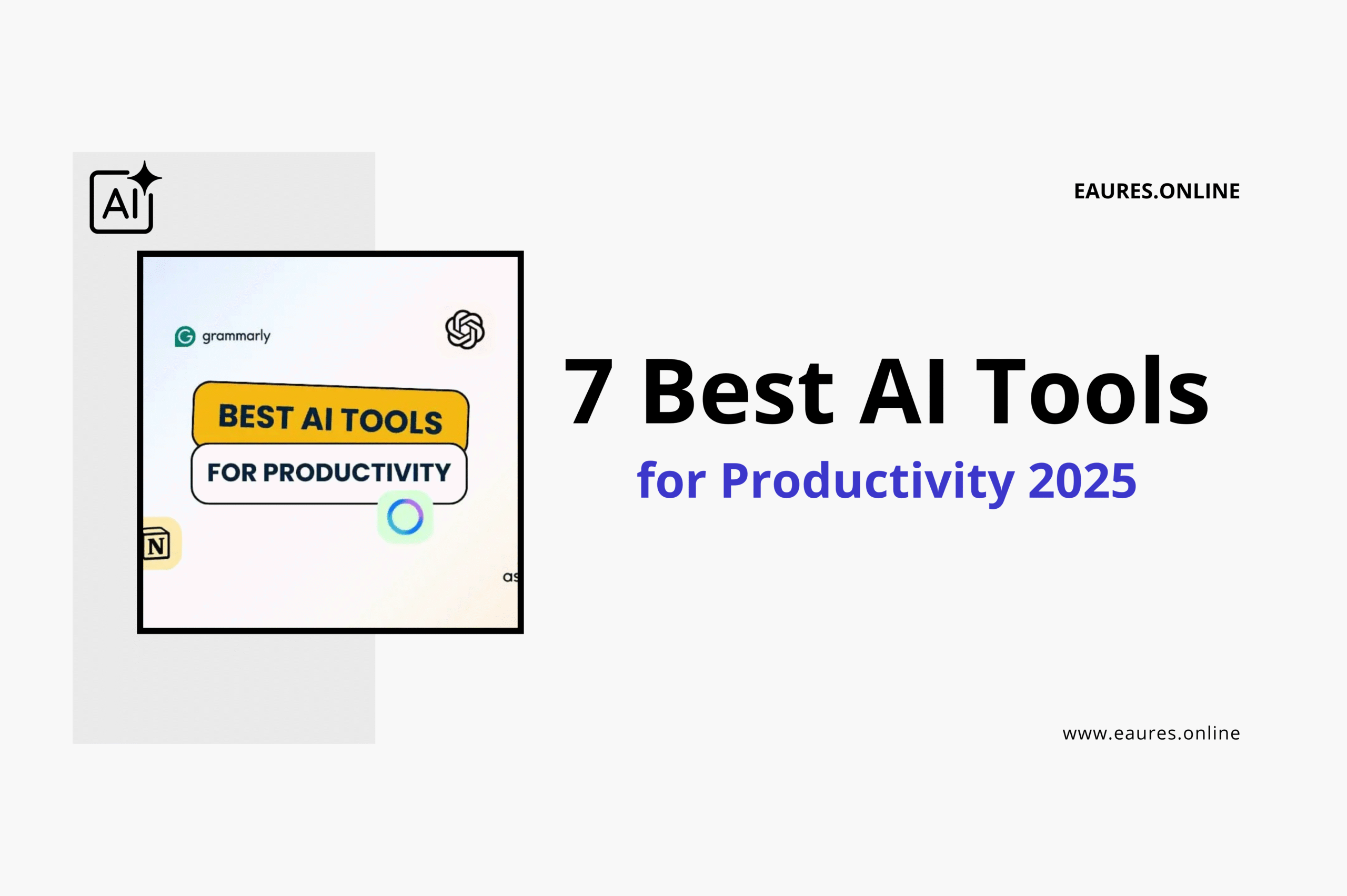Table of Contents
7 Best AI Tools for Productivity 2025
Why the Best AI Tools for Productivity Matter in 2025
Knowledge work has shifted from “more apps” to “smarter workflows.” The Best AI Tools for Productivity now live inside the tools you already use, automate multi‑step tasks, and surface answers from your organization’s knowledge in seconds. In 2025, the winners are not just the cleverest chatbots; they’re platforms that blend reasoning, automation, and secure access to your files, chats, meetings, and metrics. This guide distills the seven standouts, explains how to choose among them, and shows how to implement the Best AI Tools for Productivity without adding noise to your stack.
If you want a broader market view before you dive in, you can scan expert roundups like Zapier’s widely cited overview of AI productivity apps in a single sitting via the practical insights in Zapier’s roundup of AI productivity tools. For a complementary, curated lens from a specialist publisher, the concise editorial picks in this Plus AI guide to top productivity tools are a useful cross‑check when shortlisting.
Summary: The 7 Best AI Tools for Productivity (2025)
- Microsoft Copilot (Microsoft 365 & Windows) – Deeply embedded work assistant for documents, spreadsheets, presentations, meetings, and OS‑level actions.
- Google Gemini for Workspace – Writing, summaries, formulas, and takeaways across Gmail, Docs, Sheets, Slides, and Meet.
- Notion AI – Knowledge Q&A plus structured workflows in databases, docs, and project spaces.
- Slack AI – Recaps, smart search, and “catch‑up” across channels and DMs.
- ClickUp AI – Task‑centric writing, requirements, and project hygiene woven into one workspace.
- Zapier with AI – Natural‑language automation across thousands of apps and data sources.
- Sembly AI – Accurate meeting transcription, summaries, action items, and cross‑platform handover.
Each pick earned its spot by pairing reliable reasoning with practical integrations and strong governance—critical traits if you want the Best AI Tools for Productivity to amplify (not complicate) your day.
How We Chose the Best AI Tools for Productivity
When we score the Best AI Tools for Productivity, we weigh five dimensions:
- Impact per click – Does the tool remove a meaningful step or decision?
- Native integration depth – Are actions available where you already work (Docs, Slides, email, OS, PM tool), not just in a separate chat?
- Knowledge quality – Can the tool ground responses in your files, messages, and context without hallucinating?
- Governance & privacy – Admin controls, data residency, and clear policies for training on your data.
- Time‑to‑value – Fast onboarding, template libraries, and role‑based playbooks that unlock value in week one.
To sharpen your evaluation, consider taking a structured course that demystifies daily workflows; many teams have benefited from the hands‑on approach in the Google course on maximizing productivity with AI tools, which pairs concepts with practical exercises.
The 7 Best AI Tools for Productivity in 2025
1) Microsoft Copilot (Microsoft 365 & Windows)
Why it’s on the list: For organizations living in Outlook, Word, Excel, PowerPoint, Teams, and Windows, Microsoft Copilot delivers the Best AI Tools for Productivity as native superpowers rather than separate tabs. It drafts, summarizes, analyzes, and orchestrates actions right where the work happens.
Standout features for productivity
- Doc drafting & refinement: Generate outlines, convert notes to docs, rewrite for tone, and cite sources in Word.
- Spreadsheet help: Turn plain‑English prompts into formulas, pivot‑table insights, and trend explanations in Excel.
- Presentation building: Transform documents into slide decks and request design adjustments in PowerPoint.
- Meeting memory: Recap Teams calls with highlights, decisions, and open questions; suggest follow‑ups and owners.
- OS‑level commands: Ask Copilot to open apps, locate files, or summarize a PDF from your desktop.
Workflow example: “Turn this report into an executive summary, propose two visualizations, and draft an email to the steering committee with bullet‑point risks.” Copilot composes the draft in Word, then hands off to Outlook with context preserved.
Where it can fall short: Copilot is strongest when your source material lives in Microsoft 365; if your team lives in other apps, you may need additional connectors or complementary tools.

2) Google Gemini for Workspace
Why it’s on the list: Gemini is the right answer for teams rooted in Gmail, Docs, Sheets, Slides, and Meet. It’s one of the Best AI Tools for Productivity because it pairs writing and analysis with live grounding in your Drive content.
Standout features for productivity
- “Help me write” and review: Draft emails and Docs in your voice and request quick edits for brevity, clarity, or tone.
- Sheet intelligence: Ask for step‑by‑step formulas, create tables from prompts, and explain anomalies in your data.
- Slides uplift: Auto‑generate speaker notes and summarize long source material into slide bullets.
- Meet takeaways: Extract highlights, action items, and questions, and route tasks to the right owners.
Workflow example: “Summarize last quarter’s customer feedback folder and convert key pain points into a prioritized backlog in Sheets.” Gemini scans linked Docs and produces a sortable list with suggested owners.
Where it can fall short: As with any assistant, quality depends on the clarity of your prompts and the richness of your Drive context. Establish shared folders and naming conventions before you scale.
3) Notion AI
Why it’s on the list: Notion blends docs, wikis, databases, and projects into a single surface—and Notion AI turns that surface into a fast, forgiving partner. For teams building living playbooks and roadmaps, it’s among the Best AI Tools for Productivity.
Standout features for productivity
- Ask your workspace: Query a product spec, SOP, or meeting notes across pages and databases, with citations.
- Database automation: Generate summaries, status updates, fill missing fields, and convert messy notes into clean entries.
- Writer in context: Draft PRDs, briefs, and research digests using linked glossary terms and past work.
- Template ecosystems: Kickstart projects with pre‑built structures and AI prompts.
Teams standardizing their work benefit from hand‑picked templates; to speed adoption, many leaders share vetted systems like these Notion AI templates for recurring projects and onboarding. If you need a ready‑made collection, you can explore Notion AI templates for teams to seed consistent workflows in week one.
Workflow example: “Turn this discovery call note into a CRM record, summarize it for Slack, and create a task with next steps.” Notion AI fills the database, drafts the summary, and spawns a linked task.
Where it can fall short: Notion AI shines inside Notion; if critical work sits in other systems, pair it with an automation layer so information flows both ways.
4) Slack AI
Why it’s on the list: Slack is where teams talk. Slack AI makes sure you don’t drown in that stream—an important reason it joins the Best AI Tools for Productivity list for 2025.
Standout features for productivity
- Channel & thread recaps: Catch up in seconds on long threads or busy channels, with links to the original messages.
- Smart search: Ask natural‑language questions like “What did we decide about the Q4 discount?” and get answers with message citations.
- Noise reduction: Summaries help you prioritize without reading everything.
Workflow example: “Summarize yesterday’s #sales‑deals and DM me the top three risks.” Slack AI compiles the highlights and includes the right message links for context.
Where it can fall short: Slack AI is excellent for internal chatter, but it’s not a replacement for a structured knowledge base. Pair it with a documentation strategy to ensure decisions live beyond chat.
To see how seasoned practitioners assemble tooling beyond chat, you might skim a real‑world practitioner’s picks in this ‘ultimate toolkit’ of AI tools, which offers grounded role‑by‑role suggestions.

5) ClickUp AI
Why it’s on the list: ClickUp unifies tasks, docs, goals, and dashboards. ClickUp AI injects intelligent drafting and consistency checks directly into that hub, securing a place among the Best AI Tools for Productivity for teams that live in project work.
Standout features for productivity
- Task‑aware writing: Draft acceptance criteria, convert notes into checklists, and propose risk mitigations.
- Docs in the loop: Turn a doc into a task breakdown with owners and due dates in one click.
- Status hygiene: Ask, “What’s at risk this sprint?” and get a list of overdue items with suggested next steps.
Workflow example: “Convert this discovery doc to a 2‑week plan with four epics, estimate effort, and draft stakeholder updates.” ClickUp AI generates sections and checklists, then fills a status message you can paste into Slack or email.
Where it can fall short: ClickUp AI is strongest for teams already standardized on ClickUp; if you’re split across multiple PM tools, consider a connective layer (see Zapier below).
6) Zapier with AI (Builder, Natural‑Language Zaps & Chat)
Why it’s on the list: Automation is how you compound the value of all the Best AI Tools for Productivity. Zapier’s AI features let you describe what you want in plain English, then assemble multi‑step workflows across thousands of apps.
Standout features for productivity
- Natural‑language builders: Say “When a form is submitted, create a CRM lead, summarize the message, and post to #sales” and let Zapier draft the skeleton.
- LLM steps: Insert AI steps that classify, summarize, or extract fields before handing data to the next app.
- AI Chat with your stack: Ask “How many demos did we book last week?” and retrieve answers from connected tools.
Workflow example: A marketing leader says, “Summarize new leads, score them by company size, and send the top five daily with context.” Zapier builds the pipe, an AI step scores leads, and a daily digest lands in Slack.
For additional inspiration on real workflows, you’ll find pragmatic patterns throughout Zapier’s detailed guide to AI productivity picks, which catalogs use cases by role and app ecosystem.
Where it can fall short: Automation multiplies good processes and bad ones. Start with clean inputs and keep humans in the loop for high‑impact steps.
7) Sembly AI (Meeting Intelligence)
Why it’s on the list: Meeting assistants are a category of their own. Sembly tops many shortlists for accurate transcription, crisp summaries, and actionable follow‑ups across Zoom, Google Meet, Teams, and Webex—making it a targeted addition to the Best AI Tools for Productivity for teams who live on calls.
Standout features for productivity
- Granular summaries: Key decisions, risks, and action items, with speaker‑linked citations.
- Cross‑platform coverage: Works with your preferred conferencing tools and calendars.
- Handover & CRM: Push concise notes to Slack, Notion, or your CRM.
Workflow example: “Join our customer interview, extract pain points, and create a Notion page plus a Jira task for the top issue.” Sembly handles the summary and integrates the handoff.
Selecting a meeting assistant is nuanced (accuracy, privacy, redaction, and multi‑language support all matter), so it’s worth consulting a category‑specific comparison such as this hands‑on survey of the best AI meeting assistants 2025 to match features with your call types.
Buyer’s Guide: Choosing the Best AI Tools for Productivity for Your Team
Map work to capability. Tie real workflows to tool strengths—document drafting vs. project execution vs. chat triage vs. automation vs. meetings.
Choose your model strategy. Many tools let you bring or select models. If you’re weighing core assistants by reasoning, cost, and context window, this head‑to‑head on Claude vs ChatGPT vs Gemini vs Llama in 2025 clarifies trade‑offs and ideal use cases.
Plan governance first. Set data boundaries, PII handling, retention, and redaction rules. Define which repositories are “source of truth” and how AI can access them.
Start with one golden path. Pick a single, measurable workflow (e.g., “from sales call to CRM record to follow‑up email”) and instrument it end‑to‑end before adding more.
Train role by role. Provide role‑specific prompt libraries and templates so each function can use the Best AI Tools for Productivity without re‑inventing format and voice.

Implementation Roadmap: 30/60/90 Days
Days 0–30: Foundation
- Define success metrics: Cycle time, rework rate, SLA adherence, first‑draft time saved.
- Set guardrails: Access scopes, approval flows, and a “human‑in‑the‑loop” gate for customer‑facing content.
- Pilot one path: For example, Gemini for Workspace plus Sembly AI to turn calls into Docs and prioritized Sheets.
Days 31–60: Scale to adjacent workflows
- Add automation: Layer Zapier with AI to route summaries, classify tickets, and post consensus updates to Slack.
- Templates & standards: In Notion, roll out a workspace with prompts and scaffolding; consider curated packs like these Notion AI templates for teams to lock in consistency.
- Measure lift: Compare pre‑/post‑pilot metrics and double down on the high‑ROI steps.
Days 61–90: Institutionalize
- Roll‑wide training: Short micro‑lessons embedded in Slack or Docs; reinforce prompt patterns and pitfalls.
- Center of excellence: Maintain prompt libraries, approved automations, and “safe‑to‑ship” examples.
- Expand by function: Marketing → ClickUp AI for briefs and calendars; Operations → Zapier with AI for alerts; Product → Notion AI for research synthesis.
If you’re a builder or developer and want a specialized track, the hands‑on benchmarks and pricing notes in this roundup of the best AI code assistants in 2025 will help you select the right IDE‑native partner.
Advanced Playbooks: Getting More from the Best AI Tools for Productivity
For Leaders & Managers
- Decision memos on demand: Ask Copilot or Gemini to convert Slack recaps into a one‑page decision brief with alternatives, risks, and owner.
- Portfolio view: In ClickUp AI, query “What’s blocked this sprint?” and broadcast a succinct update to stakeholders.
For Sales & Success
- Call → CRM → cadences: Use Sembly to extract pain points and next steps, then have Zapier classify and route high‑intent leads while Slack AI posts a digest.
- Proposal acceleration: Draft a tailored proposal in Google Docs or Word with Copilot/Gemini and back it with summarized case studies.
For Marketing
- Campaign in a day: Notion AI synthesizes research into a brief; ClickUp AI turns it into tasks; Gemini drafts emails; Zapier publishes and reports.
- Content governance: Use AI to enforce tone and brand rules across channels and maintain a living style guide.
For Product & Engineering
- Requirements clarity: ClickUp AI turns a concept note into consistent PRDs; Notion AI links research to decisions.
- Developer acceleration: Pair your workspace tools with code‑first assistants; the survey of code assistants and pricing helps teams pick the right pairings by stack and editor.
Governance, Risk, and Compliance (GRC) with AI
Adopting the Best AI Tools for Productivity is as much about process as technology.
- Data scope: Restrict assistants to approved drives and channels; label sensitive content and mask by default.
- Audit trails: Favor tools that log prompts, actions, and outputs for compliance and coaching.
- Human review: Automate generation, not judgment. Make sure final decisions—pricing, contracts, public posts—stay human‑owned.
- Education: Teach teams to cite sources, verify numbers, and avoid over‑confident outputs from any assistant.
For a video‑first introduction your team can watch over lunch, a quick walkthrough of AI productivity fundamentals like the one in this YouTube session is a light‑lift way to build shared vocabulary before rollout.
FAQs: Best AI Tools for Productivity (2025)
1) What’s the fastest way to see ROI?
Pick one cross‑app workflow where time is visibly leaking—sales handoffs, weekly reporting, or support triage. Combine a core assistant (Gemini or Copilot) with automation (Zapier) and a meeting layer (Sembly) to remove copy‑paste work. With clear metrics (e.g., “time to first draft”), you’ll see impact in weeks.
2) Are general chatbots enough?
General assistants are great for ideation, but the Best AI Tools for Productivity are embedded: they read your documents, your tickets, your chats, and your meetings, then take actions in those systems.
3) How do we avoid data leakage?
Use enterprise controls: tenant‑scoped models, robust DLP, redaction in meeting tools, and clear training policies. Keep confidential content in sanctioned repositories and audit access frequently.
4) How should we handle change management?
Treat adoption like a product launch. Brand your initiative, recruit champions in each function, and celebrate “before/after” wins. Provide job‑specific templates so people start from strong defaults.
5) Which tool is best for small teams?
If you’re all‑in on Google, start with Gemini plus Slack AI for communication, and add Zapier for glue. If you’re Microsoft‑centric, Copilot plus Sembly will carry you far, with Notion AI as your flexible knowledge hub.

Honorable Mentions
There are many excellent solutions beyond this core seven. If you want a wider survey of Best AI Tools for Productivity from practitioners across industries, you’ll find practical examples and selection tips in this Plus AI roundup and deeper “how I actually use it” commentary in this practitioner toolkit. As always, map features to your real workflows, not the other way around.
Conclusion: Putting the Best AI Tools for Productivity to Work
The Best AI Tools for Productivity in 2025 don’t ask you to work somewhere new—they come to where your work already lives. Start with one golden path, measure ruthlessly, and combine core assistants with automation and meeting intelligence. Whether you operate in Microsoft 365 or Google Workspace, whether your collaboration hub is Slack or Notion, the seven tools above will help you reclaim time, reduce rework, and ship with confidence. Build a small, durable stack, and let your templates, prompts, and automations compound the gains month after month.




